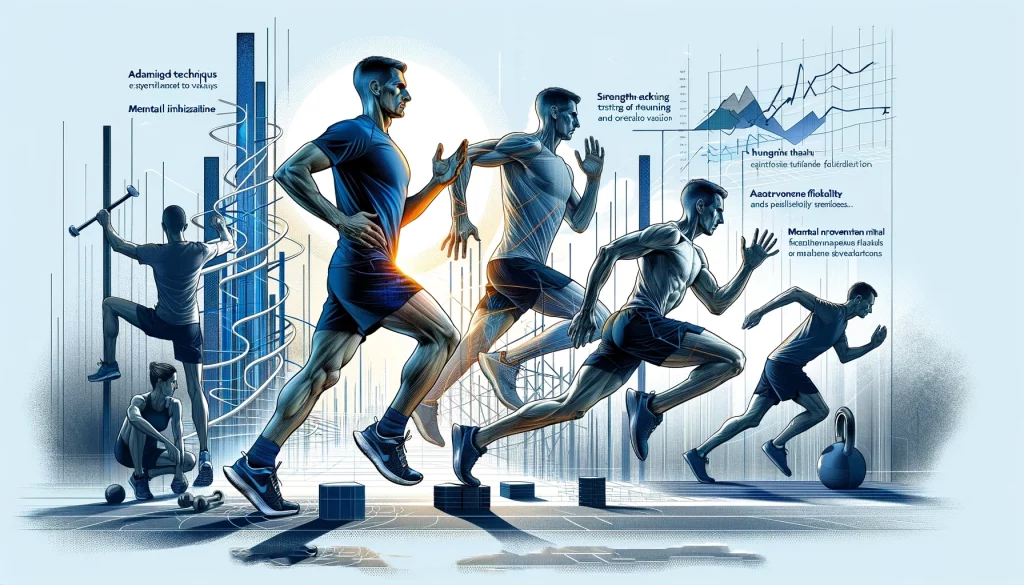Running Form and Technique Introduction

Running is often seen as a straightforward physical activity, actually encompasses a world of technique and form that can significantly impact a runner’s performance and health. This means form and technique is not just about improving speed or endurance, but it’s about moving in a way that is efficient, effective, and most importantly, safe.
Good running form can mean the difference between a satisfying run and an injury-laden experience. It helps in reducing the stress on the body, minimizing the risk of injuries, and ensuring that each stride is as efficient as possible. Whether you’re a beginner or a seasoned marathoner, understanding and applying the principles of proper running technique is crucial.
This excellent research explains that running technique is an Important Component of Running Economy and Performance” demonstrates that specific aspects of running technique, such as pelvis movement, knee joint angles, and stride parameters, significantly influence running economy and performance. Analyzing 97 endurance runners, it found that technique accounts for a substantial part of the variance in these areas, suggesting that targeted improvements in these aspects can enhance overall running efficiency and speed.
The Basics of Proper Running Form

Running form is much more than just putting one foot in front of the other; it’s a blend of posture, stride, and movement that comes together to create an efficient and effective running experience. Let’s break down the essential components of good running form.
Posture
Plays a pivotal role in running technique. Proper posture is not just about standing tall; it’s about aligning your body to minimize stress and maximize efficiency. Avoid slouching or hunching your upper body while running, as this can lead to inefficiencies and potential injuries.
Eyes and Head Position
Where you look while running can surprisingly impact your form. Your gaze should be fixed on the ground about 10 to 20 feet ahead of you, not on your feet. This position helps maintain a neutral neck posture and ensures that you are aware of your surroundings, making your run safer and more efficient.
Understanding Stride
Your running stride is another critical component of your form. A common misconception is that a longer stride equals faster running. However, overstriding, especially with a heel strike, can increase injury risk. Ideally, your foot should land directly under your body, not ahead of it.
Significance of Maintaining Proper Running Form

At its core, proper running form is about moving in a way that is natural and efficient for your body. It’s about finding a balance where each stride feels fluid, and each footfall is not a jarring shock but a smooth transition. Good form ensures that the body works in harmony, distributing the impact of running evenly and leveraging the natural mechanics of our anatomy. This efficiency is vital as it translates to better endurance, speed, and a more enjoyable running experience. More crucially, it plays a significant role in staying injury-free. As running is a high-impact activity, incorrect form can amplify the stress on joints and muscles, leading to common injuries like shin splints, runner’s knee, and IT band syndrome. By mastering proper form, runners can significantly reduce these risks.
Foot Strike and Stride

Understanding and optimizing your foot strike and stride are essential for mastering running form and technique. These elements not only influence your running efficiency but also play a significant role in injury prevention.
The Importance of Foot Strike
The way your foot lands with each step, known as the foot strike, is a cornerstone of proper running form. There are three main types of foot strikes:
Forefoot Strike
Landing on the balls of your feet. This type is common among sprinters and can lead to more speed but requires strong calf muscles and can stress the Achilles tendon.
Midfoot Strike
Your foot lands flat, distributing impact more evenly. This strike is often recommended for its balance of efficiency and reduced injury risk.
Heel Strike
Landing on the heel first. Common among long-distance runners, this can be efficient but sometimes leads to higher impact forces on the joints.
Stride Length and Cadence
Stride length and cadence (steps per minute) are closely linked to foot strike. An optimal stride is one where your foot lands under your center of gravity, not far ahead. This reduces braking forces and maintains forward momentum. To improve your stride, focus on increasing your cadence. A higher step rate with shorter strides can be more efficient and reduce injury risk. The ideal cadence varies, but many experts suggest aiming for around 180-200 steps per minute.
Glute Strength and Activation in Running

The glutes play a critical role in running, acting as powerful drivers of the leg and stabilizers of the pelvis. Strong and active gluteal muscles are essential for efficient running form, providing the necessary propulsion and support.
- Role of Glutes in Running: The gluteal muscles, primarily the gluteus maximus, are among the strongest in the body. They are crucial for powerful leg extension and hip stability during running. When engaged properly, they help maintain pelvic alignment, reducing the risk of injuries associated with imbalances, such as iliotibial band syndrome and knee pain.
- Activating and Strengthening the Glutes: Activating the glutes before a run can enhance their function during the activity. Simple activation exercises such as glute bridges and clamshells can ‘wake up’ these muscles, making them more effective during running. For strengthening, consider exercises like glute bridges, squats, lunges, and single-leg deadlifts.
Arm Swing and Upper Body Movement
Arm swing and upper body stability are crucial for balanced and efficient running.
- Arm Swing: The movement of your arms can help drive you forward and maintain balance. Keep your arms bent at a roughly 90-degree angle and swing them forward and back, not across your body. This coordination helps maintain balance and forward momentum. Avoid clenching your fists or tensing your shoulders, as this can lead to unnecessary fatigue.
- Upper Body Movement: Your upper body should remain relatively stable and upright while running. A slight forward lean from the ankles, not the waist, is acceptable and can help propel you forward. Strengthen your core to support your running form.
Breathing and Core Engagement

Breathing and core strength are vital yet often overlooked aspects of running form and technique.
- Breathing Techniques: Adopting a rhythmic breathing pattern and focusing on deep, diaphragmatic breathing can greatly benefit your running efficiency. This ensures a consistent oxygen flow and helps in maintaining a relaxed state, reducing fatigue.
- Core Engagement: A strong core is foundational for good running technique, stabilising your body and preventing excessive movement. Engage your core slightly while running and incorporate core-strengthening exercises into your training regimen.
Customising Your Running Form

Each runner’s body is unique, requiring slight adjustments in running technique to suit individual needs and styles.
- Tailoring Form to Individual Needs: Understand your body’s strengths and weaknesses to customize your form, such as focusing on avoiding overstriding or refining arm swing.
- Form Differences: Sprinters vs. Long-Distance Runners: Sprinters often use a more aggressive forefoot strike and a higher knee lift for speed and power, while long-distance runners favor a midfoot strike and a more relaxed upper body for endurance.
Training and Practice to Improve Running Form
Developing good running technique requires consistent training and practice.
- Drills and Exercises: Incorporate specific drills and exercises into your training to target various aspects of running form, such as foot strike, leg turnover, and arm swing.
- The Role of Regular Practice: Regular practice is key to ingraining good habits and unlearning inefficient patterns. Beginners should start with foundational programs like a couch to 5k program.
Advanced Techniques for Experienced Runners

Experienced runners can refine their form with specific advanced techniques.
- Fine-Tuning Your Stride: Experiment with stride variations and use running analysis tools for detailed insights.
- Maximizing Efficiency Through Interval Training: Enhance form under varying intensities with interval training, improving cardiovascular fitness and form adaptability.
- Strength and Flexibility Training: Incorporate strength and flexibility exercises for better stability and injury prevention.
- Mental Focus and Visualization: Employ mental training techniques like visualization to improve performance and maintain form.
Experienced runners can find more strategies in our running speed and endurance post.
FAQs: Mastering Running Form and Technique

- What Constitutes Proper Running Form?
Proper running technique includes maintaining a good posture, ensuring correct foot strike and stride, balancing arm swing, engaging the core, and practicing effective breathing techniques. It’s about moving in a way that is efficient, effective, and reduces injury risk. - How Should Your Feet Hit the Ground When Running?
Ideally, your foot should land directly under your body. Depending on your running style and speed, this could be a midfoot strike, where your foot lands flat, or a forefoot strike, common among sprinters, where you land on the balls of your feet. - Why is Running Form Important?
Good running technique is crucial for enhancing running efficiency, increasing speed, and reducing the risk of injuries. It ensures that the body works in harmony, distributing the impact of running evenly, and leveraging the natural mechanics of our anatomy. - Can Improving Running Technique Help with Speed and Endurance?
Yes, refining your running technique can significantly improve both speed and endurance. Efficient form allows for better energy conservation and more powerful strides, which translates to increased speed. Additionally, a good form reduces the risk of fatigue and injury, aiding in endurance. - How Can Beginners Learn Proper Running Form?
Beginners can start by focusing on basic aspects such as maintaining an upright posture, avoiding overstriding, and practicing a comfortable foot strike. Incorporating simple drills and exercises into regular training can help. Also, seeking advice from a coach or using resources like a “couch to 5k” program can provide structured guidance.



